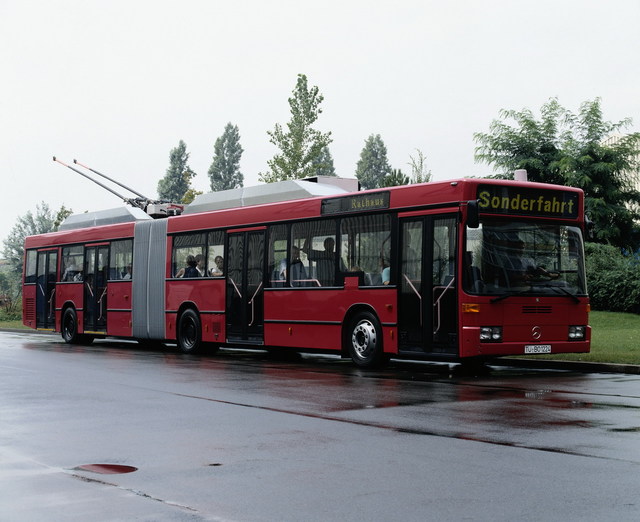Eh quelli berlinesi si...... il colore caccarella è stato tolto a Luglio 1996. Con l'arrivo dei Man DN 95 ed i Volvo.Anche se le nuove forniture di qualche anno prima erano già in giallo-grigio topo. Il resto proprio no. Ecco l'ultima fornitura color caccarella:
http://www.berliner-verkehr.de/busbilder/2252.jpg
del 1995.Pensare che lo stesso anno a Potsdam provarono questo dalla livrea veramente molto bella,per dei filobus sia per Zurigo che per Stoccarda:
 O 405 GNTD: The renaissance of wheel hub motors
O 405 GNTD: The renaissance of wheel hub motors
With the O 405 GNTD Daimler-Benz again took up the idea of wheel hub motors, now almost a century old. Since the early days of the “Mixte” drive system enormous progress had been made, of course. In the earlier experimental electric vehicles of the 1970s, DC shunt motors had been used, whereas the four ZF wheel hub motors of the dual-powered articulated bus were asynchronous motors that worked with three-phase current. Their continuous output was 50 kilowatts each; the maximum output, 75 kilowatts. Outside the trolley wire network the energy was supplied by a 300 hp OM 447 hLA diesel engine.
Apart from the Zurich dual-powered articulated bus, 17 further articulated buses of type O 405 GNDE without current collectors but with a diesel-electric hybrid drive were completed, the first of which went into operation on April 28, 1997, on Line 42 of Stuttgart’s local public transport company. The articulated buses were preceded by the 1117 Hybrid, a medium-duty truck presented by Daimler-Benz in 1994 at the Frankfurt Motor Show, as test vehicle. Wheel hub motors promised advantages mainly in low-floor buses where there was no room for a transmission and other power-transmitting components. Installed transversely and horizontally in the rear of the bus, the 300 hp EURO II engine OM 447 hLA drove a generator that supplied current to the four wheel hub motors.
Daimler-Benz went a step further with the low-floor interurban hybrid bus O 405 NÜH. Unlike the O 405 GNDE the interurban bus could switch off the diesel engine and continue operating in town centers in pure battery mode, emission-free. For this purpose the manufacturer tested novel sodium-nickel chloride batteries, also called zebra batteries, for the first time. They were developed by the Daimler-Benz subsidiary AEG in Ulm. They were considerably lighter than the old lead batteries: a set of four batteries weighed 800 kilograms, was mounted on the roof, and worked at an operating temperature of 300°C.
Four vehicles of this type went into operation in September 1996 between Oberstdorf, Sonthofen and Kempten, sponsored by the Bavarian State Ministry for Regional Development and Environmental Protection. Theoretically the low-floor buses could have gone some 30 to 40 kilometers in pure battery mode. But this was not the reasoning behind the test setup, for in this case the bus would then have needed a longer downtime to recharge the batteries. The distance which the bus covered in emission-free operation in the centers of the health resorts was only about ten kilometers. The aim of trial operation was to make optimal use of the power of the diesel engine through intelligent energy management and so simultaneously cut consumption and reduce the burden on the environment.
[Modificato da Cori x 13/03/2012 22:03]